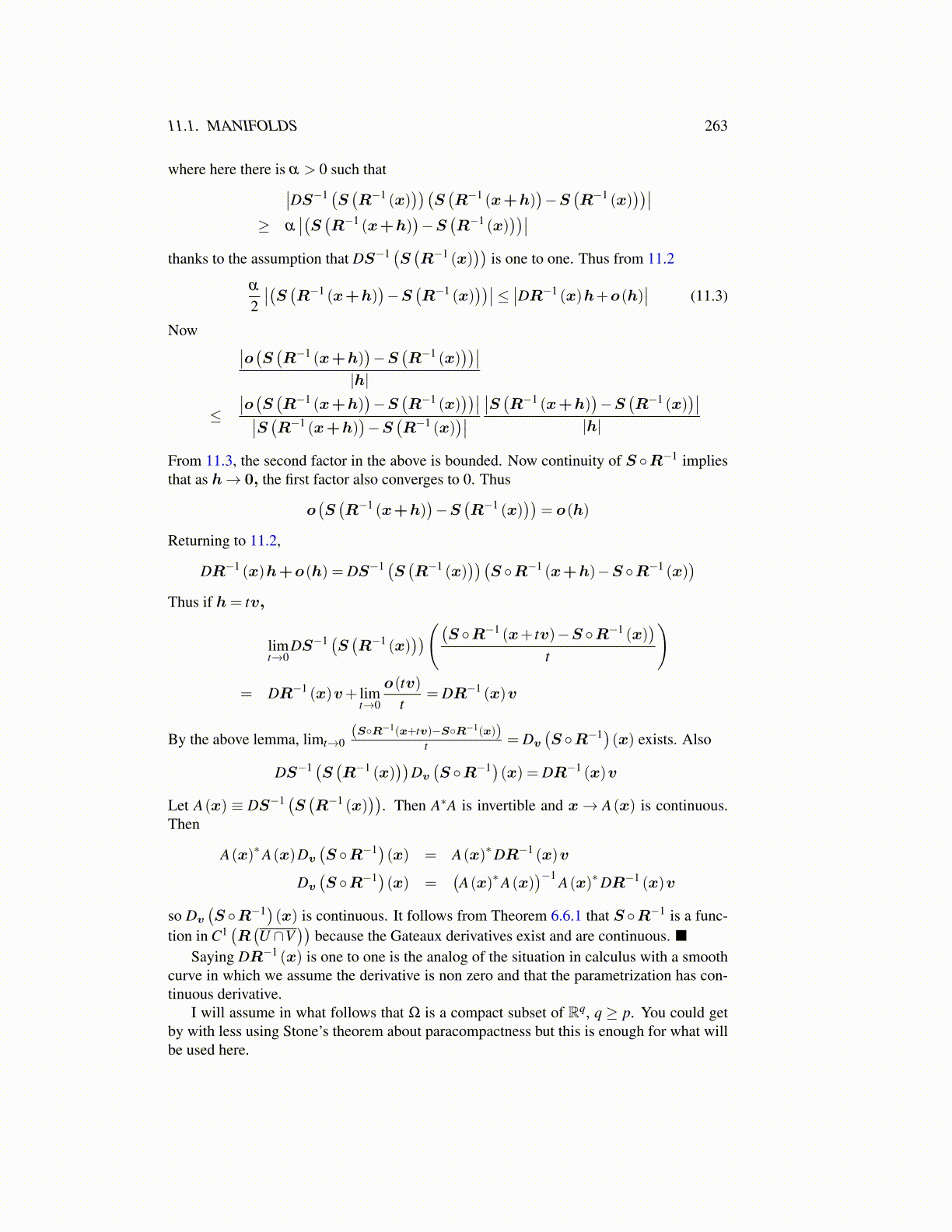
11.1. MANIFOLDS 263
where here there is α > 0 such that∣∣DS−1 (S (R−1 (x)))(
S(R−1 (x+h)
)−S
(R−1 (x)
))∣∣≥ α
∣∣(S (R−1 (x+h))−S
(R−1 (x)
))∣∣thanks to the assumption that DS−1 (S (R−1 (x)
))is one to one. Thus from 11.2
α
2
∣∣(S (R−1 (x+h))−S
(R−1 (x)
))∣∣≤ ∣∣DR−1 (x)h+o(h)∣∣ (11.3)
Now ∣∣o(S (R−1 (x+h))−S
(R−1 (x)
))∣∣|h|
≤∣∣o(S (R−1 (x+h)
)−S
(R−1 (x)
))∣∣∣∣S (R−1 (x+h))−S
(R−1 (x)
)∣∣∣∣S (R−1 (x+h)
)−S
(R−1 (x)
)∣∣|h|
From 11.3, the second factor in the above is bounded. Now continuity of S ◦R−1 impliesthat as h→ 0, the first factor also converges to 0. Thus
o(S(R−1 (x+h)
)−S
(R−1 (x)
))= o(h)
Returning to 11.2,
DR−1 (x)h+o(h) = DS−1 (S (R−1 (x)))(
S ◦R−1 (x+h)−S ◦R−1 (x))
Thus if h= tv,
limt→0
DS−1 (S (R−1 (x)))((S ◦R−1 (x+ tv)−S ◦R−1 (x)
)t
)
= DR−1 (x)v+ limt→0
o(tv)t
= DR−1 (x)v
By the above lemma, limt→0(S◦R−1(x+tv)−S◦R−1(x))
t = Dv
(S ◦R−1)(x) exists. Also
DS−1 (S (R−1 (x)))
Dv
(S ◦R−1)(x) = DR−1 (x)v
Let A(x) ≡ DS−1 (S (R−1 (x)))
. Then A∗A is invertible and x→ A(x) is continuous.Then
A(x)∗A(x)Dv
(S ◦R−1)(x) = A(x)∗DR−1 (x)v
Dv
(S ◦R−1)(x) =
(A(x)∗A(x)
)−1 A(x)∗DR−1 (x)v
so Dv
(S ◦R−1)(x) is continuous. It follows from Theorem 6.6.1 that S ◦R−1 is a func-
tion in C1(R(U ∩V
))because the Gateaux derivatives exist and are continuous. ■
Saying DR−1 (x) is one to one is the analog of the situation in calculus with a smoothcurve in which we assume the derivative is non zero and that the parametrization has con-tinuous derivative.
I will assume in what follows that Ω is a compact subset of Rq, q ≥ p. You could getby with less using Stone’s theorem about paracompactness but this is enough for what willbe used here.